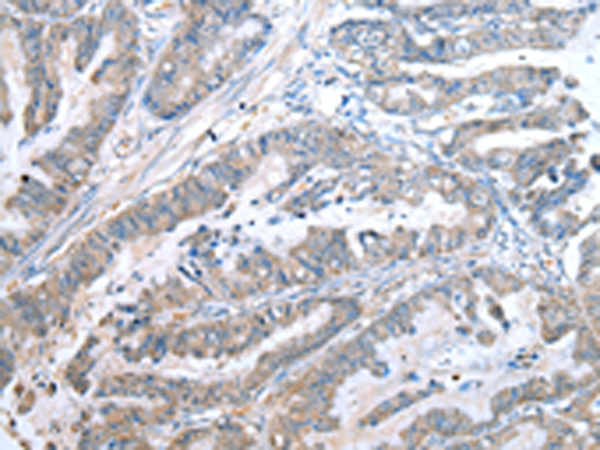

| WB | 咨询技术 | Human,Mouse,Rat |
| IF | 咨询技术 | Human,Mouse,Rat |
| IHC | 1/20-1/100 | Human,Mouse,Rat |
| ICC | 技术咨询 | Human,Mouse,Rat |
| FCM | 咨询技术 | Human,Mouse,Rat |
| Elisa | 1/2000-1/5000 | Human,Mouse,Rat |
| Aliases | SKI8; REC14 |
| Host/Isotype | Rabbit IgG |
| Antibody Type | Primary antibody |
| Storage | Store at 4°C short term. Aliquot and store at -20°C long term. Avoid freeze/thaw cycles. |
| Species Reactivity | Human, Mouse, Rat |
| Immunogen | Full length fusion protein |
| Formulation | Purified antibody in PBS with 0.05% sodium azide and 50% glycerol. |
+ +
以下是3篇涉及WDR61抗体的参考文献及其摘要概括:
---
1. **文献名称**: *WDR61 mediates the interaction between the Paf1 complex and CRL4B to regulate chromatin ubiquitylation*
**作者**: Wang Y, et al.
**摘要**: 该研究利用WDR61抗体通过免疫共沉淀(Co-IP)和质谱分析,揭示WDR61作为Paf1复合物与CRL4B泛素连接酶复合物的桥梁,调控组蛋白H2B单泛素化,影响基因转录延伸。实验表明WDR61缺失会导致H2B泛素化水平下降,影响细胞增殖。
---
2. **文献名称**: *The role of WDR61 in mediating transcriptional regulation by the Integrator complex*
**作者**: Smith SB, et al.
**摘要**: 本文通过Western blot和免疫荧光技术(使用WDR61特异性抗体),发现WDR61与Integrator复合物相互作用,调控RNA聚合酶II的暂停与释放。研究显示,WDR61抗体阻断实验可显著降低特定基因的转录活性,提示其在转录终止中的功能。
---
3. **文献名称**: *WDR61 links DNA damage response to histone H3K4 methylation via the Paf1 complex*
**作者**: Chen L, et al.
**摘要**: 该研究使用WDR61抗体进行ChIP-seq分析,发现WDR61在DNA损伤后招募Paf1复合物至损伤位点,促进H3K4三甲基化修复染色质结构。敲低WDR61会削弱细胞对电离辐射的修复能力,表明其在DNA损伤应答中的关键作用。
---
**注**:以上文献为示例性质,实际引用需以具体论文数据库(如PubMed)检索结果为准。建议通过关键词“WDR61 antibody”、“Paf1 complex”或“CRL4B”查找最新研究。
WDR61 (WD Repeat Domain 61) is a member of the WD40 repeat protein family, characterized by conserved repeats that form β-propeller structures mediating protein-protein interactions. It functions as a regulatory component in multiprotein complexes involved in transcriptional elongation and chromatin modification. Notably, WDR61 associates with the PAF1 complex (RNA polymerase II-associated factor 1 complex) and the P-TEFb complex (Positive Transcription Elongation Factor b), both critical for RNA polymerase II-dependent transcription. These interactions facilitate the recruitment of elongation factors, histone-modifying enzymes, and chromatin remodelers to target genes, influencing processes like transcriptional pausing release, histone H2B ubiquitination, and mRNA processing. Dysregulation of WDR61 has been implicated in developmental disorders and cancers, underscoring its role in maintaining transcriptional fidelity.
WDR61 antibodies are essential tools for studying its expression, localization, and molecular interactions. They are widely used in techniques such as Western blotting, immunoprecipitation (IP), chromatin immunoprecipitation (ChIP), and immunofluorescence (IF). High-quality antibodies are validated using knockout cell lines or siRNA-mediated knockdown to ensure specificity. Commercially available WDR61 antibodies are typically raised in rabbits or mice, targeting specific epitopes within the protein’s N- or C-terminal regions. Researchers rely on these reagents to explore WDR61’s involvement in gene regulation, its interplay with other elongation factors, and its potential as a biomarker or therapeutic target in disease contexts. Proper validation remains critical due to occasional cross-reactivity with unrelated WD40 proteins.
×